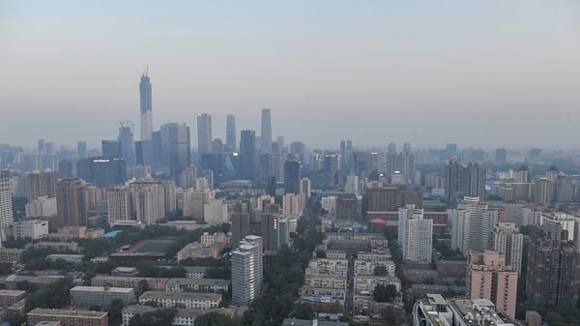
Beijing sees a slightly polluted day in May. Ozone pollution has emerged as a new threat to the city's air quality. (Photo/Global Times)
The Beijing-Tianjin-Hebei region has seen notable progress in tackling PM2.5 air pollution after four years of an official campaign but it now faces severe ozone pollution, according to a new report from Peking University.
This is the fourth report by the university's Center of Statistical Science and Guanghua School of Management evaluating the air quality in China's key areas.
The annual average concentration of PM2.5, tiny airborne particles that are particularly harmful to human health, in the 13 cities in the Beijing-Tianjin-Hebei region saw a 27-percent decrease from 100.1 micrograms per cubic meter in 2013 to 72.5 in 2016, according to analysis of over 44 million pieces of data collected from almost 100 facilities monitoring air quality between March 2013 and May 2017.
The region as a whole is likely to reach the target set by the State Council in 2013 to reduce the PM2.5 concentration by 25 percent by the end of this year, the report predicted, as long as concentration levels don’t bounce back too much from 2016.
However, the 13 cities have experienced different levels of improvement. Beijing, for example, declined only 6.7 percent to 77.2 micrograms per cubic meter last year, still a long way off the target of 60 by the end of 2017.
While there have been achievements in controlling PM2.5 air pollution, the report also pointed out severe ozone pollution in the urban sprawl around the Chinese capital.
Ozone is a powerful greenhouse gas and a widespread air pollutant in many major cities. The region’s annual average concentration of ozone increased 13.3 percent in 2016 from 2013.
High concentrations of ground-level ozone can harm people's health, leading to respiratory problems, lung disease and asthma attacks.
Beijing has had 53 days with excessive ground-level ozone concentrations since May, 7 percent more than the annual average in the same period of the past five years, a member of staff at the Beijing Environmental Monitoring Center told the Global Times.
"In summers, this invisible oxygen pollution worsens, and governments should set reduction targets to control it, like they did in combating PM2.5," said Chen Songxi, leader of the Peking University survey.


















































